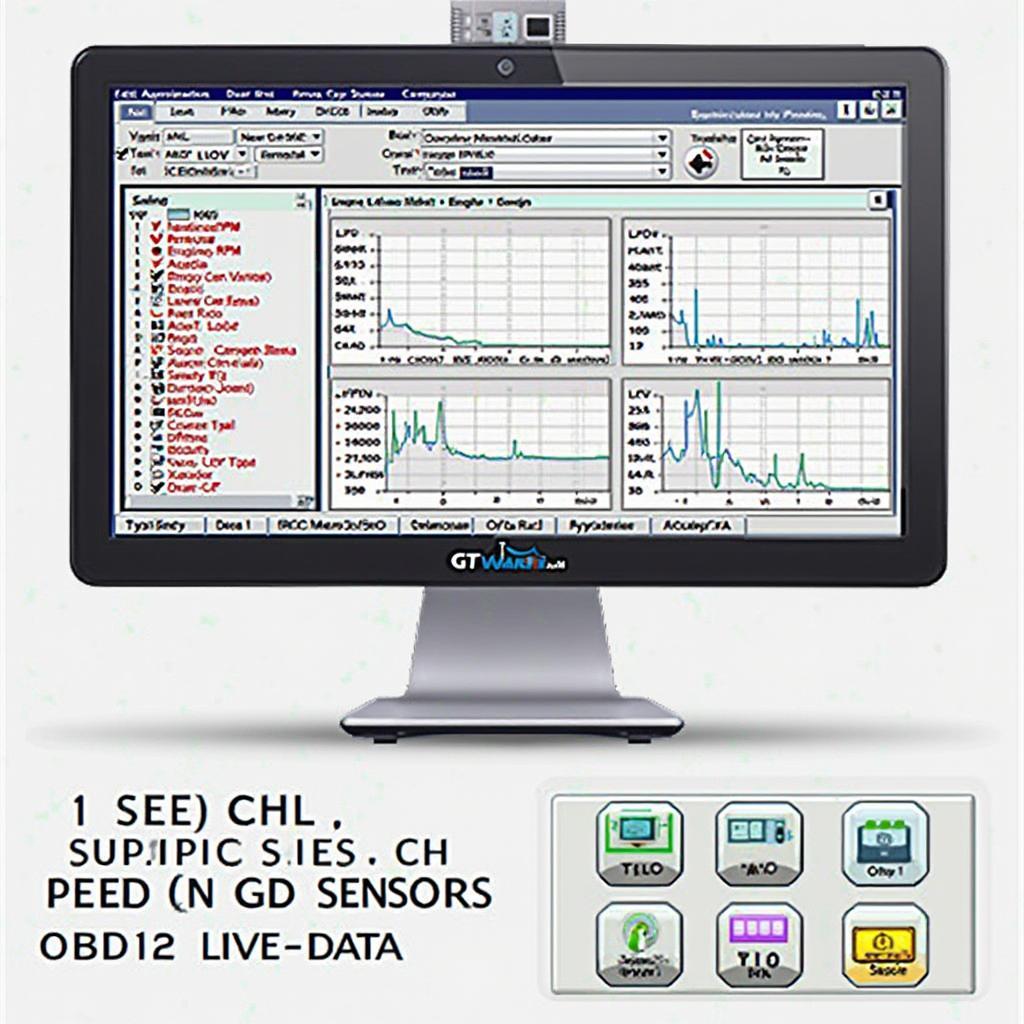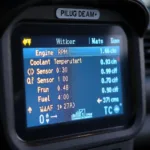Live data from your OBD2 scanner can be an incredibly powerful tool for diagnosing car problems, offering a real-time look into your vehicle’s inner workings. Whether you’re a seasoned mechanic or a DIY enthusiast, understanding which parameters to monitor with your OBD2 scanner can save you time and money. This checklist will guide you through essential live data parameters and help you interpret the readings.
 Live Data OBD2 Scanner Display
Live Data OBD2 Scanner Display
Understanding the Power of Live Data
OBD2 live data provides dynamic readings from your vehicle’s sensors, unlike static diagnostic trouble codes (DTCs) which only indicate a past issue. Live data lets you see what’s happening in real-time, allowing for a more precise diagnosis and helping you identify intermittent problems that might not trigger a DTC. This is especially useful for diagnosing complex issues or verifying repairs. For example, checking your obd2 scanner brakes can provide real-time feedback on brake performance.
What is a Live Data OBD2 Checklist?
A live data OBD2 checklist is a guide that helps you focus on the most important parameters for diagnosing common car problems. It’s like having a roadmap to navigate the wealth of information your OBD2 scanner provides. This checklist can be tailored to the specific issue you are trying to diagnose.
Key Live Data Parameters and Their Significance
Engine RPM
Engine RPM, or revolutions per minute, is a fundamental parameter indicating engine speed. Fluctuations or unusual readings can point to problems with the ignition system, fuel delivery, or other mechanical issues.
Coolant Temperature
Monitoring coolant temperature is crucial to prevent overheating. Readings that are consistently high or fluctuate significantly can indicate a faulty thermostat, a failing water pump, or a leak in the cooling system.
Oxygen Sensor (O2) Readings
O2 sensors measure the amount of oxygen in the exhaust gases, which is critical for proper fuel mixture and catalytic converter efficiency. Abnormal readings can indicate a faulty O2 sensor, vacuum leaks, or problems with the fuel injectors. If you’re looking for an OBD2 scanner at places like Walmart, make sure it supports live data for O2 sensors. You can check out our article on obd2 scanner at walmart for more information.
Short-Term and Long-Term Fuel Trim
Fuel trim values indicate how much the engine computer is adjusting the fuel mixture to maintain the optimal air-fuel ratio. Large deviations from zero can suggest issues with the O2 sensors, MAF sensor, or fuel pressure.
Intake Air Temperature (IAT)
The IAT sensor measures the temperature of the air entering the engine. Inaccurate readings can affect fuel efficiency and engine performance. This is particularly important when diagnosing problems related to air intake and fuel delivery.
Mass Air Flow (MAF) Sensor Readings
The MAF sensor measures the amount of air entering the engine. This information is critical for calculating the correct fuel mixture. Incorrect readings can lead to poor fuel economy and performance issues.
Vehicle Speed Sensor (VSS) Readings
The VSS measures the speed of the vehicle. Inaccurate readings can affect the transmission, cruise control, and other systems that rely on speed information.
Manifold Absolute Pressure (MAP) Sensor Readings
The MAP sensor measures the pressure inside the intake manifold. This information is used to calculate engine load and adjust fuel delivery. Incorrect readings can lead to performance issues and poor fuel economy.
Building Your Own Live Data OBD2 Checklist
While the parameters above cover the most common needs, you can tailor your checklist to specific diagnostic scenarios. For example, if you’re trying to figure out why your 95 eg convert to obd2 isn’t working correctly, focusing on O2 sensor and fuel trim data would be crucial. Similarly, if you have questions about whether a does.94 honda.accors have obd2, referring to model-specific resources can be helpful. You might also check our list of obd2 car code reader walmart to find a compatible scanner.
Conclusion: Mastering Live Data for Effective Diagnostics
Mastering live data analysis with your OBD2 scanner is invaluable for accurate and efficient car diagnostics. By utilizing a comprehensive live data OBD2 checklist, you can quickly pinpoint the root cause of car problems, saving both time and money. This knowledge empowers you to make informed decisions about repairs, ensuring your vehicle runs smoothly and reliably.
FAQs
-
What is live data on an OBD2 scanner?
Live data is real-time information from various vehicle sensors. -
Why is live data important for car diagnostics?
It helps diagnose intermittent problems and provides more precise diagnoses. -
What are some common live data parameters to monitor?
RPM, coolant temperature, O2 sensor readings, and fuel trim. -
How can I interpret live data readings?
Compare them to manufacturer specifications or use a repair manual. -
Where can I find more information on OBD2 scanners?
Websites like OBDFree offer comprehensive resources.
Need Support? Contact us via WhatsApp: +1(641)206-8880, Email: [email protected] or visit us at 789 Elm Street, San Francisco, CA 94102, USA. Our customer service team is available 24/7.
